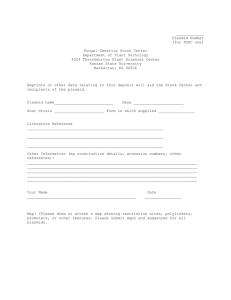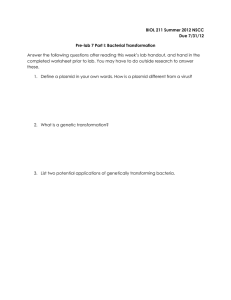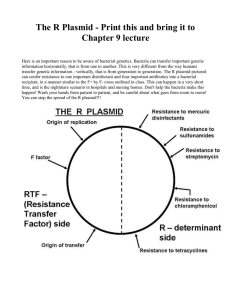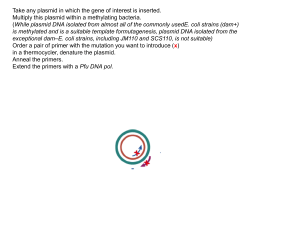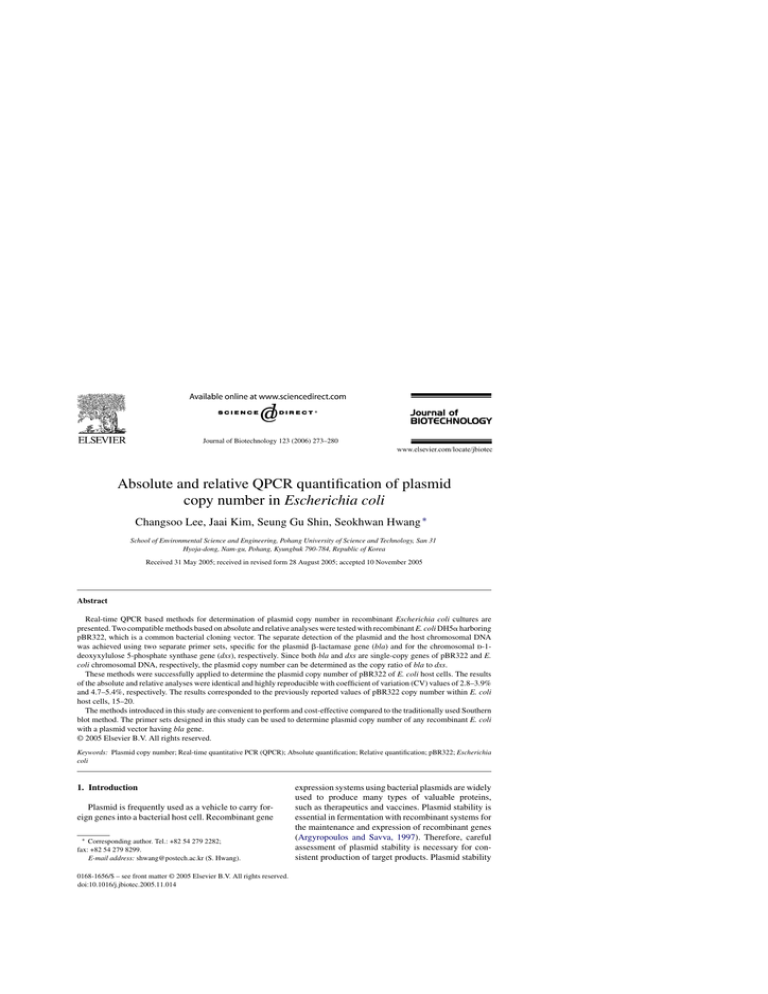
Journal of Biotechnology 123 (2006) 273–280
Absolute and relative QPCR quantification of plasmid
copy number in Escherichia coli
Changsoo Lee, Jaai Kim, Seung Gu Shin, Seokhwan Hwang ∗
School of Environmental Science and Engineering, Pohang University of Science and Technology, San 31
Hyoja-dong, Nam-gu, Pohang, Kyungbuk 790-784, Republic of Korea
Received 31 May 2005; received in revised form 28 August 2005; accepted 10 November 2005
Abstract
Real-time QPCR based methods for determination of plasmid copy number in recombinant Escherichia coli cultures are
presented. Two compatible methods based on absolute and relative analyses were tested with recombinant E. coli DH5␣ harboring
pBR322, which is a common bacterial cloning vector. The separate detection of the plasmid and the host chromosomal DNA
was achieved using two separate primer sets, specific for the plasmid -lactamase gene (bla) and for the chromosomal d-1deoxyxylulose 5-phosphate synthase gene (dxs), respectively. Since both bla and dxs are single-copy genes of pBR322 and E.
coli chromosomal DNA, respectively, the plasmid copy number can be determined as the copy ratio of bla to dxs.
These methods were successfully applied to determine the plasmid copy number of pBR322 of E. coli host cells. The results
of the absolute and relative analyses were identical and highly reproducible with coefficient of variation (CV) values of 2.8–3.9%
and 4.7–5.4%, respectively. The results corresponded to the previously reported values of pBR322 copy number within E. coli
host cells, 15–20.
The methods introduced in this study are convenient to perform and cost-effective compared to the traditionally used Southern
blot method. The primer sets designed in this study can be used to determine plasmid copy number of any recombinant E. coli
with a plasmid vector having bla gene.
© 2005 Elsevier B.V. All rights reserved.
Keywords: Plasmid copy number; Real-time quantitative PCR (QPCR); Absolute quantification; Relative quantification; pBR322; Escherichia
coli
1. Introduction
Plasmid is frequently used as a vehicle to carry foreign genes into a bacterial host cell. Recombinant gene
∗ Corresponding author. Tel.: +82 54 279 2282;
fax: +82 54 279 8299.
E-mail address: shwang@postech.ac.kr (S. Hwang).
0168-1656/$ – see front matter © 2005 Elsevier B.V. All rights reserved.
doi:10.1016/j.jbiotec.2005.11.014
expression systems using bacterial plasmids are widely
used to produce many types of valuable proteins,
such as therapeutics and vaccines. Plasmid stability is
essential in fermentation with recombinant systems for
the maintenance and expression of recombinant genes
(Argyropoulos and Savva, 1997). Therefore, careful
assessment of plasmid stability is necessary for consistent production of target products. Plasmid stability
274
C. Lee et al. / Journal of Biotechnology 123 (2006) 273–280
also provides an insight into understanding general features of the cells during replication, transcription and
translation in the presence of extrachromosomal DNA
(Summers, 1991).
Genetic stability of recombinant plasmid can
be evaluated both qualitatively and quantitatively
(Fujimura et al., 1996). Qualitatively, it should be
shown that the structure of the inserted gene is stable. Qualitative analysis is generally easy to perform
because bacterial plasmids is readily recovered and
propagated in host cells. Quantitatively, it should be
demonstrated that the copy number of the recombinant
plasmid is stable within the host cells. Therefore, a reliable method to quantify the copy number of the plasmid
of interest is needed for quantitative analysis.
A plasmid copy number (PCN) assay is a widely
used method in quantitative genetic stability analysis
(Fujimura et al., 1996). Traditionally, the plasmid copy
number has been determined by measuring band density produced through a DNA hybridization method
(Korpela et al., 1987; Fujimura et al., 1996). However, the method presents safety problems in handling
radioactively labeled probes, and the procedure is laborious and time-consuming (Pushnova et al., 2000). The
radioactive probe used for hybridization can also cause
inaccuracy of quantification results due to its short
life span (Pushnova et al., 2000). Therefore, a reliable
method is required for accurate determination of plasmid copy number.
Real-time quantitative PCR (QPCR) technology
offers fast and reliable quantification of any target
sequence in a sample (Burgos et al., 2002). While
there are many methods available for quantification
of nucleic acids, real-time QPCR is at present the
most sensitive and precise method (Ferre, 1992; Klein,
2002). In this study, we introduced two convenient
ways to determine the plasmid copy number: absolute
and relative quantification methods using a real-time
QPCR. Adequacy of each method was also demonstrated by determining the plasmid copy number of the
pBR322 within Escherichia coli DH5␣. To our knowledge, this is the first report to determine plasmid copy
number by absolute and relative quantification methods using a real-time QPCR. The plasmid and the host
cell are most commonly used. These methods are faster
and cost-effective compared to the DNA hybridization
without any safety problems. Moreover, the methods
are easy to perform and thus could be applied to mon-
itor plasmid copy number in a time-course study or in
a recombinant bioprocess.
2. Materials and methods
2.1. Strains
E. coli DH5␣, grown in LB medium at 37 ◦ C, was
used as the host strain for all transformation procedures. Recombinant E. coli transformed using pBR322
was cultured in LB medium at 37 ◦ C with addition
of 100 g/ml of ampicillin (Sigma). The recombinant
strain was used as a test organism for the determination
of plasmid copy number.
2.2. Design of primer sets for real-time QPCR
Two primer sets specific to the -lactamase gene
(bla) and to the d-1-deoxyxylulose 5-phosphate synthase gene (dxs) were designed and denoted as the blaand dxs-set, respectively. The bla is a single-copy gene
of pBR322 (Watson, 1988), and the dxs is a singlecopy gene of E. coli chromosomal DNA (Hahn et al.,
2001). Consequently, quantification of sample with the
bla- and dxs-set represents corresponding amount of
pBR322 and E. coli chromosomal DNA. The primer
sets were designed using Primer3 software [Rozen and
Skaletsky, 2000] based on the pBR322 sequence and
the E. coli dxs sequence. The sequences of the primers
are shown in Table 1.
2.3. Preparation of template DNA for real-time
QPCR
The E. coli DH5␣ transformant cells harboring
pBR322 were cultured in two identical culture tubes
(i.e., 50 ml). Total DNA was extracted from each of the
cultures during the exponential growth phase, which
was determined by periodic measurement of optical
density (OD) at 600 nm. The extraction was performed
using the QIAamp DNA Mini kit (Qiagen), following
a method for bacterial cells described in the manufacturer’s instructions. The template DNA extracted
from E. coli was normalized to 2 ng/l with deionized
and distilled water (DDW) for consistent QPCR assay.
The concentration of extracted DNA was measured
using aTD-700 fluorometer (Turner Designs) with the
C. Lee et al. / Journal of Biotechnology 123 (2006) 273–280
275
Table 1
Sequences of primers for real-lime QPCR
Target
Accession no.
Primers (5 → 3 )a
Length (nt)
Primer position
bla
J10749
F: CTACGATACGGGAGGGCTTA
R: ATAAATCTGGAGCCGGTGAG
20
20
3382–3401
3443–3462
81
dxs
AF035440
F: CGAGAAACTGGCGATCCTTA
R: CTTCATCAAGCGGTTTCACA
20
20
1509–1528
1602–1621
113
a
Product size (bp)
F and R indicate forward and reverse primers, respectively.
PicoGreen dsDNA Quantification Reagent (Molecular
Probes). The prepared template DNA was analyzed to
quantify bla and dxs in triplicate in real-time QPCR
assay.
2.4. Real-time QPCR using SYBR Green I dye
Real-time QPCR amplification and analysis were
performed using a LightCycler instrument with software version 3.5 (Roche Diagnostics). The threshold
cycle (CT ) was determined by the ‘Fit Points Method’
in the software.
The QPCR assays with the sets were optimized with
respect to the MgCl2 concentration and the annealing
temperature (Yu et al., 2005). The optimal conditions
were 3 mM MgCl2 and 62 ◦ C for both primer sets
detecting the bla and dxs (data not shown). The realtime QPCR mixture of 20 l was prepared using the
LightCycler FastStart DNA Master SYBR Green I kit
(Roche Diagnostics): 12.4 l PCR-grade water, 1.6 l
MgCl2 stock solution (final concentration 3 mM), 1 l
of each primer (final concentration 0.5 M), 2 l reaction mix 10× solution, and 2 l template DNA. The
thermal cycling protocol was as follows: initial denaturation for 10 min at 95 ◦ C followed by 40 cycles of 10 s
at 95 ◦ C, 10 s at 62 ◦ C and 10 s at 72 ◦ C. The fluorescence signal was measured at the end of each extension
step at 72 ◦ C. After the amplification, a melting curve
analysis with a temperature gradient of 0.1 ◦ C/s from
70 to 95 ◦ C was performed to confirm that only the
specific products were amplified. Finally, the samples
were cooled down to 40 ◦ C for 30 s.
SYBR Green I dye binds to double-stranded DNA
in a sequence-independent way and emits fluorescence;
thus specific and non-specific PCR products are both
detected (Deprez et al., 2002). Therefore, amplification of non-specific PCR products must be avoided for
exact quantification (Wilhelm et al., 2003). A melting
curve analysis is frequently performed to rule out nonspecific PCR (Ririe et al., 1997). The melting process
of double-stranded DNA causes a sharp reduction in
the fluorescence signal around the melting temperature
(Tm ) of the PCR product, resulting in a clear peak in
the negative derivative of the melting curve (−dF/dT).
Therefore, different fragments with different melting
temperatures appear as separate peaks (Ririe et al.,
1997).
2.5. Construction of standard curves for plasmid
copy number determination
The PCR product of primers specific for dxs of
E. coli was amplified by conventional PCR using the
dxs-set (Table 1). The reaction mixture of 50 l contained 10 mM Tris–HCl (pH 9.0), 40 mM KCl, 1.5 mM
MgCl2 , 250 M of each deoxynucleotide (dNTP),
0.5 mM of each primer, 2.5 U Taq DNA polymerase
(Takara), and 50 ng E. coli DH5␣ genomic DNA template. PCR amplification was performed with a PTC100 thermal cycler (MJ research) according to the following program: an initial denaturation at 95 ◦ C for
5 min, followed by 35 cycles of 30 s at 95 ◦ C, 30 s at
55 ◦ C and 1 min at 72 ◦ C; a final extension at 72 ◦ C
for 5 min. The PCR product was purified using the
GENECLEAN Turbo kit (Qbio gene) and cloned into
a pGEM-T Easy vector (Promega). The cloned plasmid was purified using the QIAprep Spin Miniprep Kit
(Qiagen). The resulting plasmid contained two separate sequences specific for bla and dxs because the
pGEM-T Easy vector contains a bla sequence identical
with the bla in pBR322. Therefore, the plasmid can be
detected by using either bla- or dxs-set. The plasmid
was denoted as pGEM-BD.
A 10-fold serial dilution series of the pGEM-BD,
ranging from 1 × 105 to 1 × 109 copies/l, was used
to construct the standard curves for both bla and dxs.
276
C. Lee et al. / Journal of Biotechnology 123 (2006) 273–280
The concentration of the plasmid was measured using
a fluorometer and the corresponding copy number was
calculated using the following equation (Whelan et al.,
2003):
3. Results
DNA (copy)
=
6.02 × 1023 (copy/mol) × DNA amount(g)
DNA length(dp) × 660(g/mol/dp)
3.1. Amplification specificity confirmation of
primer sets
(1)
CT values in each dilution were measured in duplicate
using a real-time QPCR with the bla- and dxs-sets to
generate the standard curves for bla and dxs, respectively. The CT values were plotted against the logarithm
of their initial template copy numbers. Each standard
curve was generated by a linear regression of the plotted points. From the slope of each standard curve, PCR
amplification efficiency (E) was calculated according
to the equation (Rasmussen, 2001):
E = 10−1/slope − 1
(2)
2.6. Absolute and relative quantification in
real-time QPCR
Absolute and relative quantification methods
(Klein, 2002) were simultaneously used to quantify the
plasmid copy. Absolute quantification determines the
exact copy concentration of target gene by relating the
CT value to a standard curve (Yu et al., 2005). Relative
quantification presents the amount of target gene in a
sample relative to another sample (i.e., a calibrator),
which contains both target and reference genes with a
constant ratio. The target/reference ratios of all samples
are normalized by the target/reference ratio of the calibrator. PCR amplification efficiencies (E) of target and
reference sequences are required for the relative calculation (Lehmann and Kreipe, 2001; Roche, 2001). The
results are expressed as a fold ratio of the normalized
target amounts. In this experiment, bla and dxs were
used as the target and reference genes, respectively.
Relative quantification was performed by the CT
method (Livak and Schmittgen, 2001):
relative amount of target = (1 + E)−CT
mosomal DNA, sample: total DNA extracted from the
transformed E. coli and calibrator: pGEM-BD.
(3)
where CT : CT of the sample − CT of the calibrator, CT : CT of the target − CT of the reference,
target: bla in pBR322, reference: dxs in E. coli chro-
The amplification specificity was checked by both
melting curve analysis and gel electrophoresis. Fig. 1
shows the melting peaks and the corresponding gel
band pictures for the real-time QPCR products with the
bla-set (A) and the dxs-set (B). The bla-set showed a
sharp peak for the PCR product of the quantitative standard sample, pGEM-BD, at 87.0 ◦ C. A single melting
peak at the same melting temperature was produced
for the PCR product of the total DNA sample. The
dxs-set showed a single melting peak for the quantitative standard as well as for the total DNA sample, at the same temperature of 86.5 ◦ C. Every PCR
product also generated prominent bands with expected
sizes in the gel electrophoresis analysis. The identity
of amplified products was additionally confirmed by
sequencing analysis (Fig. 1). These results indicated
that non-specific PCR products with the primer sets
were not detected in the analyzed temperature range.
3.2. Standard curves and amplification efficiencies
The standard curves for bla and dxs, each ranging from 1 × 105 to 1 × 109 copies/l, are shown in
Fig. 2A. Both curves were linear in the range tested
(R2 > 0.999) by the duplicate reactions. The slopes of
the standard curves for bla and dxs were −3.42 and
−3.43, respectively, which were identical (Nystorm et
al., 2004). From the slopes, a high amplification efficiency of 0.96 was determined for both bla and dxs in
the investigated range and was used for relative quantification.
3.3. Validation of the CT method
For the CT calculation to be valid, the amplification efficiencies of the target and reference must be
approximately equal (Etarget = Ereference = E). The variation of CT , the CT deviation between bla and dxs,
with template dilution was examined to validate the
C. Lee et al. / Journal of Biotechnology 123 (2006) 273–280
277
Fig. 1. Confirmation of PCR amplification specificities of bla-set (A) and the dxs-set (B). Melting peaks were examined for the bla- and the
dxs-sets with a quantitative standard sample (solid line) and an E. coli total DNA sample (dashed line) as templates. Gel electrophoresis of the
PCR products was performed on 1% agarose gel. The melting temperatures and the amplicon sizes were 87.0 ◦ C and 81 bp for the bla-set, and
86.5 ◦ C and 113 bp for the dxs-set. For each set, the identity of the amplified products was confirmed by DNA sequencing analysis.
278
C. Lee et al. / Journal of Biotechnology 123 (2006) 273–280
CT method. The CT was calculated using each of
the 10-fold serial dilutions of the pGEM-BD. A plot of
the logarithm of initial copy number versus CT was
made (Fig. 2B) and the slope of the regression line was
close to zero (0.0028). This indicates that the amplification efficiencies of bla and dxs are identical enough for
the CT calculation (Livak and Schmittgen, 2001).
3.4. Determination of plasmid copy number
Fig. 2. Construction of the standard curves for bla and dxs (A) and
validation of the CT calculation (B). The standard curves were
constructed with serial 10-fold dilutions of the pGEM-BD, ranging
from 1 × 105 to 1 × 109 copies/l. Each standard dilution was amplified by real-time QPCR using bla- and dxs-set in duplicate. For each
gene, determined CT values were plotted against the logarithm of
their known initial copy numbers (n = 2). A standard curve was generated by linear regression through these points (A). The CT , the
CT deviation of bla vs. dxs, was calculated for each dilution and
plotted (n = 2) (B). Average CT = average ± S.D. (n = 10).
Real-time QPCR amplifications of the total DNA
samples from two separate cultures of E. coli DH5␣
harboring pBR322 and standard samples were performed simultaneously. Absolute quantification was
performed using the standard curves constructed
(Fig. 2A). The absolute copy numbers of bla and dxs in
the E. coli total DNA samples were determined from
the corresponding standard curves, using the CT values. The plasmid copy number of pBR322 was then
calculated by dividing the copy number of bla by the
copy number of dxs. Because bla and dxs are singlecopy genes of pBR322 and E. coli chromosomal DNA,
respectively, the ratio of bla to dxs is equal to the plasmid copy number of pBR322. The results from the
absolute quantification and the calculated plasmid copy
numbers are shown in Table 2. The total DNA samples
from the two separate cultures showed similar plasmid
copy numbers of 18.7 and 18.3.
For relative quantification, bla and dxs were used
as the target and the reference genes, respectively.
Because pGEM-BD (i.e., calibrator) contained one
copy of each dxs and bla specific sequence, the copy
ratio of bla to dxs in the calibrator is also 1. Therefore, the result from the CT calculation is equal
to the copy ratio of bla to dxs, i.e., the plasmid copy
number of pBR322 in the sample. The CT of the
calibrator was given as 0.40 ± 0.05 by averaging the
Table 2
Estimated plasmid copy number (PCN) by absolute quantification
Culture
1
2
a
b
c
CT a
Copiesb (copies/l)
PCNc
bla
dxs
bla
dxs
13.73 ± 0.03
13.86 ± 0.03
17.68 ± 0.05
17.78 ± 0.04
1.12× 107
5.98 × 105 (3.4%)
5.61 × 105 (2.8%)
Average ± S.D. (n = 3).
Average (coefficient of variation) (n = 3).
Average (coefficient of variation) (n = 3).
(2.0%)
1.03 × 107 (2.1%)
18.7 (3.9%)
18.3 (3.5%)
C. Lee et al. / Journal of Biotechnology 123 (2006) 273–280
279
Table 3
Estimated plasmid copy number (PCN) by relative quantification
Culture
CT samplea
−3.95 ± 0.06
−3.92 ± 0.05
1
2
a
b
c
d
Calibratorb
0.40 ± 0.05
0.40 ± 0.05
CT c
−4.35 ± 0.08
−4.32 ± 0.07
PCNd
2−CT
1.96−CT
20.5 (5.4%)
20.0 (4.8%)
18.7 (5.4%)
18.4 (4.7%)
Average ± S.D. (n = 3).
Calculated from the serial dilutions of the quantitative standard sample used for standard curve construction. Average ± S.D. (n = 10).
Average ± S.D. (n = 3).
Average (coefficient of variation) (n = 3).
CT values determined from the 10-fold serial dilutions of the pGEM-BD (Fig. 2B). The determination
of CT of each dilution was performed in duplicate.
The results from the relative quantification and the calculated plasmid copy numbers are shown in Table 3.
Based on Eq. (3) with the assumption that the amplification efficiency (E) is 1, the plasmid copy number
was determined by the 2−CT calculation. The results
were 20.5 and 20.0 for the total DNA samples from the
separate E. coli cultures. Using the experimentally calculated value (Fig. 2A) of 0.96 for E in Eq. (3), the
plasmid copy numbers were 18.7 and 18.4 for each
sample. This calculation was also valid because the
amplification efficiencies of bla and dxs were almost
identical to each other (Fig. 2).
The results from both absolute and relative quantification were reproducible and close to the reported
values. The plasmid copy number of pBR322 is known
to be 15–20 within E. coli host cells (Muesing et al.,
1981; Lin-Chao and Bremer, 1986; Qiagen, 2004). The
coefficient of variation (CV) values calculated from
the absolute and relative quantification results were
2.8–3.9% and 4.7–5.4%, respectively. These values are
about half the CV from a recent report on the development of a new plasmid copy number assay method,
7.1–9.8% (Pushnova et al., 2000).
4. Discussion
We demonstrated the feasibility of two real-time
QPCR methods to determine plasmid copy number. The absolute and relative quantification methods
require the separate detection of the plasmid and the
host chromosomal DNA. The detection is performed
using a primer set specific to a single-copy gene in
each target molecule.
In this study, SYBR Green I dye was used in realtime QPCR analysis because it has several advantages
over sequence-specific probes when singleplex PCRs
are performed. Both detection formats have about
the same detection limit, reproducibility, and dynamic
range (Deprez et al., 2002; Wilhelm et al., 2003). The
accumulation of primer dimers and the amplification
of non-specific PCR products can be analyzed only in
SYBR Green I detection (Deprez et al., 2002). In a
previous study, SYBR Green I detection was used to
determine host DNA contamination in plasmid preparations and provided a reliable alternative to traditional
blotting methods and to more expensive TaqMan protocols (Vilalta et al., 2002).
We applied the real-time QPCR based methods to
quantify the plasmid copy number of pBR322 within
E. coli DH5␣ host cells. The results corresponded to
the previously known values and were precise with CV
values of 2.8–5.4% (Tables 2 and 3). It should be noted
that the relative quantification results were nearly equal
to the absolute quantification results when the calculated value of amplification efficiency (E), 0.96, was
used for the (1 + E)−CT calculation. This agreement
means that the relative quantification based method
established in this study was successfully applied to the
determination of plasmid copy number in the DNA.
For reliable analysis, stable storage of quantitative
standards is very important. We used the recombinant
plasmid pGEM-BD as a standard sample. Use of cloned
targets in carrier DNA is common in real-time QPCR
analyses (Whelan et al., 2003).
Two real-time QPCR methods (i.e., absolute and relative) with the primer sets designed in this study and
the pGEM-BD can be directly applied to any recombinant system which uses a plasmid containing bla with
E. coli as the host cell. The ampicillin resistance gene,
bla is one of the most frequently used genetic markers
280
C. Lee et al. / Journal of Biotechnology 123 (2006) 273–280
for recombinant plasmid, and E. coli is the most popular host cell for bacterial recombination. Therefore, the
present technique should be widely applicable.
Acknowledgement
This research was supported in part by the Korea
Energy Management Corporation and Advanced Environmental Biotechnology Research Center (AEBRC)
(Grant No. R11-2003-006-02002-0) program.
References
Argyropoulos, D., Savva, D., 1997. A fast fluorescence method for
accurate determination of plasmid copy number in Bacillus subtilis. Biotechnol. Tech. 11, 605–609.
Burgos, J.S., Ramirez, C., Tenorio, R., Sastre, I., Bullido, M.J., 2002.
Influence of reagents formulation on real-time PCR parameters.
Mol. Cell. Probe 16, 257–260.
Deprez, R.H.L., Fijnvandraat, A.C., Ruijter, J.M., Moorman, A.F.M.,
2002. Sensitivity and accuracy of quantitative real-time polymerase chain reaction using SYBR green I depends on cDNA
synthesis conditions. Anal. Biochem. 307, 63–69.
Ferre, F., 1992. Quantitative or semi-quantitative PCR: reality versus
myth. PCR Meth. Appl. 2, 1–9.
Fujimura, H., Sakuma, Y., Weimer, T., 1996. A quantitative method
for the determination of plasmid copy number in recombinant
yeast. Biologicals 24, 67–70.
Hahn, K., Eubanks, L.M., Testa, C.A., Blagg, B.J., Baker, J.A., Poulter, C.D., 2001. 1-deoxy-D-xylulose 5-phosphate synthase, the
gene product of open reading frame (ORF) 2816 and ORF 2895
in Rhodobacter capsulatus. J. Bacteriol. 183, 1–11.
Klein, D., 2002. Quantification using real-time PCR technology:
applications and limitations. Trends Mol. Med. 8, 257–260.
Korpela, K., Buchert, P., Soderlund, H., 1987. Determination of plasmid copy number with nucleic acid sandwich hybridization. J.
Biotechnol. 5, 267–277.
Lehmann, U., Kreipe, H., 2001. Real-time PCR analysis of DNA
and RNA extracted from formalin-fixed and paraffin-embedded
biopsies. Methods 25, 409–418.
Lin-Chao, S., Bremer, H., 1986. Effect of the bacterial growth rate
on replication control of plasmid pBR322 in Escherichia coli.
Mol. Gen. Genet. 203, 143–149.
Livak, K.J., Schmittgen, T.D., 2001. Analysis of relative gene expression data using real time quantitative PCR and the 2−CT
method. Methods 25, 402–408.
Muesing, M., Tamm, J., Shepard, H.M., Polisky, B., 1981. A single
base-pair alteration is responsible for the DNA overproduction
phenotype of a plasmid copy-number mutant. Cell 24, 235–
242.
Nystorm, K., Biller, M., Grahn, A., Lindh, M., Larson, G., Olofsson,
S., 2004. Real time PCR for monitoring regulation of host gene
expression in herpes simplex virus type 1-infected human dipoild
cells. J. Virol. Meth. 118, 83–94.
Pushnova, E.A., Geier, M., Zhu, Y.S., 2000. An easy and accurate
agarose gel assay for quantitation of bacterial plasmid copy numbers. Anal. Biochem. 284, 70–76.
Qiagen, 2004. Origin of replication and copy number of various plasmids and cosmids. Qiagen Literature Resoreces.
http://www1.qiagen.com/resources/info/plasmid specifications.
aspx#1.
Rasmussen, R., 2001. In: Meuer, S., Wittwer, C., Nakagawara,
K. (Eds.), Quantification on the LightCycler. Springer-Verlag,
Berlin, Germany, pp. 21–34.
Ririe, K.M., Rasmussen, R.P., Wittwer, C.T., 1997. Product differentiation by analysis of DNA melting curves during the polymerase
chain reaction. Anal. Biochem. 245, 154–160.
Roche, 2001. LightCycler: Relative Quantification. Technical Note,
LC13/2001, pp. 1–28.
Rozen, S., Skaletsky, H., 2000. Primer 3 on the WWW for general
users and for biologist programmers. Methods Mol. Biol. 132,
365–386.
Summers, D.K., 1991. The kinetics of plasmid loss. Trends Biotechnol. 9, 273–278.
Vilalta, A., Whitlow, V., Martin, T., 2002. Real-time PCR determination of Escherichia coli genomic DNA contamination in plasmid
preparations. Anal. Biochem. 301, 151–153.
Watson, N., 1988. Anew revision of the sequence of plasmid pBR322.
Gene 70, 399–403.
Whelan, J.A., Russel, N.B., Whelan, M.A., 2003. A method for
the absolute quantification of cDNA using real time PCR. J.
Immunol. Meth. 278, 261–269.
Wilhelm, J., Pingoud, A., Hahn, M., 2003. Real-time PCR-based
method for the estimation of genome sizes. Nucl. Acids Res. 31,
e56.
Yu, Y., Lee, C., Kim, J., Hwang, S., 2005. Group-specific primer
and probe sets to detect methanogenic communities using quantitative real-time polymerase chain reaction. Biotechnol. Bioeng.
89, 670–679.

